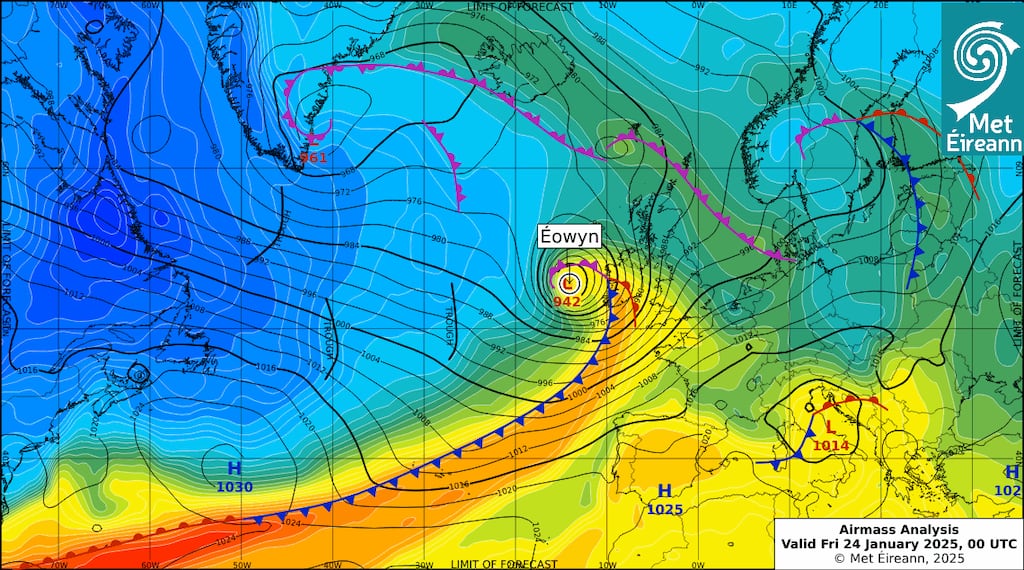Two weather stations experienced hurricane-force mean wind speeds as Storm Éowyn buffeted Ireland last month, according to Met Éireann data.
The forecaster’s meteorological report for January confirms “the provisional highest (sustained and gust) wind speeds” for Ireland since records have been recorded digitally.
These were at Mace Head, Co Galway, early on Friday January 24th, where the fastest gust was 184km/h and the highest 10-minute mean wind speed was 142km/h.
Three other stations broke their highest gust records during the storm: Finner, Co Donegal (150km/h); Athenry, Co Galway (139km/h); and Gurteen, Co Tipperary (124km/h).
RM Block
Ten-minute mean wind speed records were also broken at Finner (115km/h); Dunsany, Co Meath (76km/h); and Athenry (83km/h).
The Mace Head and Malin Head stations reached hurricane force 12 on the Beaufort wind scale, Met Éireann said.
The forecaster said January was a typical winter month with the final third “dominated by a powerful Atlantic jet stream, which steered several active low-pressure systems towards western Europe”.
Éowyn went through “explosive cyclogenesis as it approached Ireland from the southwest on Thursday 23rd and reached peak intensity as it brushed by the northwest coast ... with a sting jet feature forming on the south side of the low”.
This brought heavy rain and extreme winds with widespread disruption and power outages.
A weather buoy off the west Cork coast recorded the highest wave – 20.2m – around the height of a six-storey building.
Valentia Observatory, Co Kerry, recorded the highest rainfall over the worst 24 hours of the storm – 28.5mm – while the coldest spot was Moorepark, Co Cork, at -4.1 degrees.
The weather in Ireland during January was nowhere near any records in terms of temperature – warm or cold – or rainfall.
However, the European Union’s Copernicus Climate Change Service said on Thursday it was the warmest January globally, with an average temperature of 13.23 degrees.
This was 1.75 degrees above the pre-industrial levels and was the 18th month in the past 19 where global-average surface air temperature was more than 1.5 degrees above the mid-19th century level.
This was despite natural La Niña conditions in the tropical Pacific and their temporary cooling effect on global temperatures.
Climate scientists had expected this exceptional spell to subside after a warming El Niño event peaked in January 2024 and conditions shifted to an opposing, cooling La Niña phase.
But the heat has lingered at record or near-record levels, prompting debate about what other factors could be driving it to the top end of expectations.
Julien Nicolas, a climate scientist at Copernicus, told Agence France-Presse: “This is what makes it a bit of a surprise: you’re not seeing this cooling effect, or temporary brake at least, on the global temperature that we were expecting to see.”
La Niña is expected to be weak, and Copernicus said prevailing temperatures in parts of the equatorial Pacific Ocean suggested a slowing or stalling of the move towards the cooling phenomenon, while it could disappear by March.
Last month, Copernicus said global temperatures averaged across 2023 and 2024 had exceeded 1.5C for the first time. This did not represent a permanent breach of the long-term 1.5-degree target under the Paris climate accord but it was a clear sign the limit was being tested.
Scientists say every fraction of a degree of warming above 1.5 degrees increases the intensity and frequency of extreme weather events such as heatwaves, heavy rainfall and droughts.
- Additional reporting: Guardian
- Join The Irish Times on WhatsApp and stay up to date
- Listen to our Inside Politics podcast for the best political chat and analysis
















